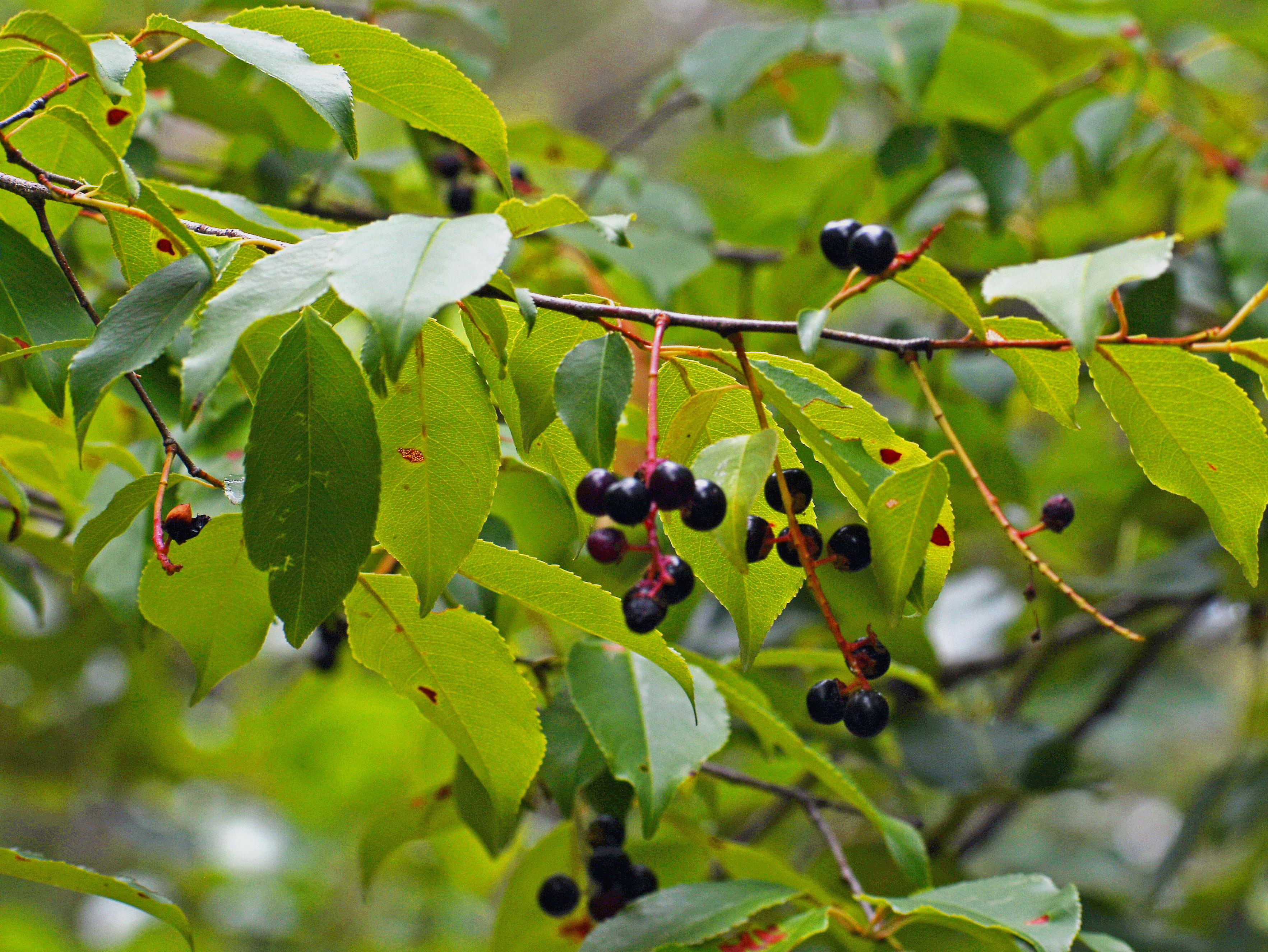
By Terry W. Johnson
For the last few weeks, Georgians have been enjoying the first peaches of the year. However, while we have been eating these sweet, fuzzy fruits, birds and other wildlife have been dining on juicy fruits produced by black cherry trees.
From late spring through fall, the slender branches of the black cherry (Prunus serotina) often hang low under the weight of clusters of round, red-to-almost-black fruits, each of which is only about a third of an inch in diameter. The black cherry tree does not mature until it is a decade old. From that point forward, it will bear fruit. However, it will not produce a heavy crop until it is 30 years old.
Unlike peaches, black cherries are far from sweet. Perhaps the best way to describe the fruit’s taste is bitter with the slightest hint of sweetness. Consequently, we have never considered wild black cherries a popular food. But native Americans ate both fresh and dried black cherries. The cherries were also a key ingredient in a dish they called pemmican, a high-calorie food that was often a staple on long trips.
Native Americans used the black cherry for medicinal purposes, too. The tree bark was ground into the consistency of powder and brewed to concoct a tea-like drink. Medicines containing black cherry were administered for a variety of respiratory illnesses and used to treat excessive bleeding. The tree’s reputation regarding respiratory problems such as coughing persists to this day. Some of the popular wild cherry cough medicines still contain an extract derived from the inner bark of the black cherry.
Although early colonists did not often eat black cherries, they did use the fruits for pies. Colonial furniture makers also fashioned the wood into high-quality, long-lasting furniture. Even today, cabinet makers rank black cherry as one of the best woods for top-of-the line furniture.
The black cherry is recognized as a valuable wildlife plant, as well. Dr. Doug Tallamy, a professor in the Department of Entomology and Wildlife Ecology at the University of Delaware, ranks black cherry and other species of the genus Prunus as his second-highest rated food plants (oaks are first). Other biologists have the black cherry second on their list of favorite fruit trees in the forests of eastern North America.
There are many reasons why the tree has earned this broad acclaim. Black cherry and other woody plants in the genus Prunes serve as host plants for 454 species of moths and butterflies. Which ones depends on where you are in Georgia. In Monroe County where I live, the list includes the eastern tiger swallowtail, red-spotted purple and viceroy butterflies. The tree is also a caterpillar host for moths such as the promethea and small-eyed sphinx.
Moths and butterflies will begin laying their eggs on black cherry leaves long before the trees produce fruit. This is not unusual: Saplings are great places for caterpillars to develop into adults: The younger trees often attract fewer predators and the leaves are sometimes more tender.
The black cherry’s fragrant flowers provide pollen and nectar for countless honeybees and native pollinators. And while the tree’s leaves and twigs are poisonous to domestic grazing animals, white-tailed deer and other wild mammals browse on black cherry without suffering any ill effects.
Its bitter fruits are gobbled up by a number of mammals including gray and fox squirrels, chipmunks, opossums, raccoons, and even black bears. More than 40 species of birds also relish black cherries. The roster includes wood thrushes, great crested flycatchers, woodpeckers, cedar waxwing, mockingbird, gray catbirds, summer tanagers, ruffed grouse, and wild turkeys.
Birds and other animals will often travel a long way to dine on ripe black cherries. This was illustrated recently when a great crested flycatcher suddenly appeared in my daughter’s backyard. This may not sound unusual until you consider that she lives in a subdivision devoid of large trees. The closest forested land is some distance away. The flycatcher was apparently drawn to a black cherry tree full of plump cherries growing in an undeveloped spot along her fence line. (I would love to know how the bird found this abundant source of food!)
My wife and I are fortunate to have a couple of black cherry trees growing on our property. The only reason they are there is we did not clear all of our land when we built our home over 50 years ago.
Black cherry trees can attain heights of 80 to 90 feet. I must confess, though, that I’ve never seen one close to that tall. Unfortunately, truly old, large black cherry trees are becoming harder to find throughout the entire state.
In spite of its value to wildlife, the black cherry tree is considered a “weed” tree by many people. Which is ironic, considering that it was introduced into Europe as an ornamental.
Perhaps you have a black cherry on your property. If you do, I hope you consider it an asset. It would be hard to find another tree that offers such a variety of animals with cover, wild pollinators with pollen and nectar, butterflies and moths with caterpillar host plants, and diverse birds and mammals with food.
And if you are one of the many people clearing land for a new home, check and see if any black cherries are growing there. If so, give serious thought to leaving it standing. If you are a wildlife enthusiast, doing so it might be one of the best landscape decisions you will make.
Terry W. Johnson is a retired Nongame program manager with the Wildlife Resources Division and executive director of The Environmental Resources Network, or TERN, friends group of the division’s Nongame Conservation Section. (Permission is required to reprint this column.) Learn more about TERN, see previous “Out My Backdoor” columns, read Terry’s Backyard Wildlife Connection blog and check out his latest book, “A Journey of Discovery: Monroe County Outdoors.”




















